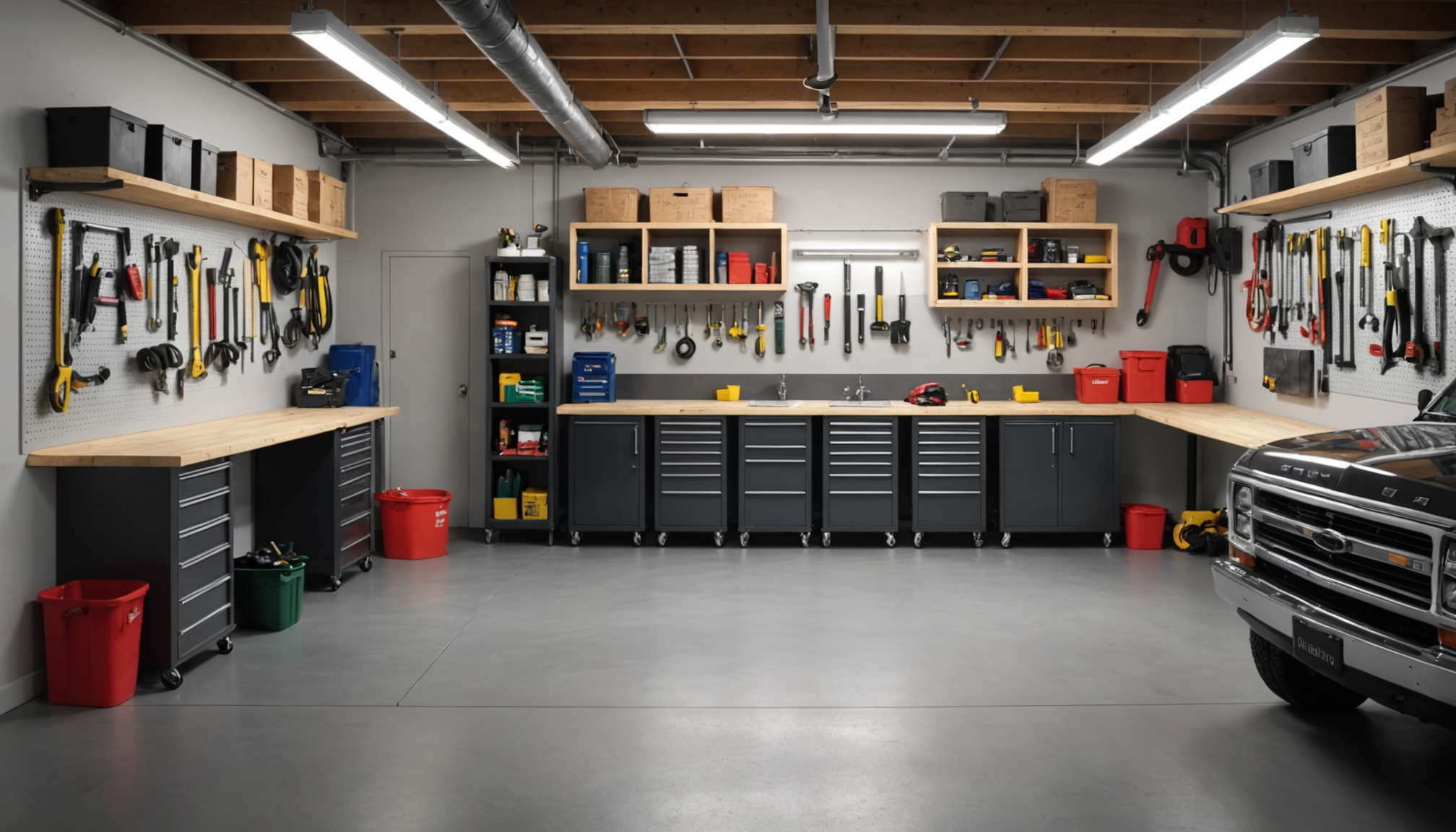Designing your garage begins with choosing the right layout, which is fundamental to achieving both functionality and aesthetic appeal. It’s essential to consider how you envision using the space and align your layout with your lifestyle and needs. Whether you’re transforming your garage into a workshop, a storage haven, or simply maintaining it as a clean, organized area for your vehicles, a thoughtfully planned layout is the foundation of an efficient and stylish garage.
Start by assessing the available space and the dimensions you have to work with. Take precise measurements of the width, length, and height of the garage, noting any structural elements like columns, windows, or doors that could influence the placement of storage and equipment. This initial measurement can also highlight any existing limitations that might affect your design, such as plumbing lines or electrical outlets that need to remain accessible.
Next, categorize the different functions you want your garage to support. This could include:
- Vehicle parking
- Storage for tools and equipment
- A workspace for hobbies or projects
- A designated area for seasonal items like holiday decorations
Once you have defined the objectives, use these functions to segment the garage into zones. Creating specific areas for each purpose allows for a more organized layout and helps in managing and maintaining the space effectively. For instance, positioning storage solutions along the garage walls will free up central space for movement, while a dedicated workbench can be located in a quiet corner, away from car parking zones.
Consider safety as a critical aspect when designing the layout. Ensure pathways are clear of obstructions to prevent accidents and maintain an easy flow of movement throughout the space. Additionally, make sure that all electrical systems are secure and that storage solutions are sturdy and well-mounted to avoid potential hazards.
Compare different layout strategies using a simple table to find the one that best fits your needs:
| Layout Strategy | Benefits |
| Open Floor Plan | Maximizes space for multiple vehicles; ideal for large garages. |
| Wall-Mounted Storage | Frees floor space, providing more room for vehicle parking and movement. |
| Zone-Based Layout | Facilitates organization by dedicating specific areas to different functions. |
No matter the layout you choose, remember to leave room for potential future adjustments. As your needs change, your garage layout should be flexible enough to accommodate those changes without requiring a complete overhaul. With a well-designed and thoughtfully executed layout, your garage will not only serve its practical purposes but also add significant value to your home.
Optimizing storage solutions
Maximizing storage solutions in your garage involves innovative thinking and a strategic approach to ensure that every available inch is utilized effectively. An organized garage not only contributes to a clean and functional space but also makes it easier to find and access your tools, equipment, and seasonal items when needed.
-
Assess Your Storage Needs:
- Catalog the items you need to store. This includes tools, sports equipment, seasonal decorations, and gardening supplies.
- Determine the frequency of use for each category. Items used often should be more accessible than those used only occasionally or seasonally.
-
Use Vertical Space:
- Install shelving units that extend as high as safely possible to maximize storage without encroaching on floor space.
- Consider using pegboards to hang tools and small items. This not only saves space but also keeps tools visible and within reach.
-
Choose the Right Storage Systems:
- Invest in modular storage systems that can be adapted as your needs change. These systems are particularly useful for dynamic environments like garages.
- Look for heavy-duty cabinets with lockable doors for storing hazardous materials, especially if safety is a concern.
-
Implement Overhead Storage:
- Use ceiling-mounted racks for long-term storage items or bulky seasonal items. Ensure these structures are installed securely to handle the weight.
- Overhead options are excellent for keeping less frequently used items out of the way yet easily accessible when needed.
-
Create Zones for Efficiency:
- Designate specific areas for different categories of items. For example, have a tool zone, a recreational equipment section, and a gardening supplies area.
- Label storage bins and containers clearly to facilitate quick identification and retrieval.
-
Regularly Reorganize and Purge:
- Periodically go through your stored items to ensure everything is necessary and in good condition. Remove items that are no longer needed or functional.
- Keeping your storage solutions adaptable means regularly reassessing and reorganizing as your needs evolve.
Incorporating these strategies will not only streamline your garage space but also enhance your safety measures by reducing clutter and potential hazards. By capitalizing on the design principles of effective storage solutions, you’ll create a garage that serves as a functional and organized extension of your home.
Selecting materials and finishes
When it comes to choosing the right materials and finishes for your garage, the decision can greatly impact both the durability and aesthetic appeal of the space. Selecting appropriate materials can enhance resilience against wear and tear while ensuring the environment is conducive for its various uses, be it parking, storage, or as a workshop.
Start by considering the flooring, which forms the foundation of your garage. Concrete is a popular choice due to its robustness and low maintenance requirements. It withstands heavy loads, which is essential when using the space for vehicle parking or heavy-duty workstations. For added protection, consider applying an epoxy coating. This not only provides a sleek, polished appearance but also adds a layer of protection against stains and moisture. Epoxy coatings are resistant to chemicals and abrasions, making them an ideal choice for garages that might face spills from oil or other substances.
For the walls and ceiling, opting for materials that can endure fluctuations in temperatures is crucial, especially if your garage isn’t climate-controlled. Sheer panels or wallboards treated to resist moisture exposure are excellent choices. In terms of finishes, paints or sealants designed for high-durability, with resistance to mildew and dirt, can prolong the neat appearance and cleanliness of the space. Opt for lighter colors to enhance lighting efficiency and make the area appear more spacious and inviting.
The selection of cabinetry and storage solutions should not be overlooked. Materials like stainless steel or powder-coated metal are ideal due to their ability to resist corrosion and withstand constant handling. For a more rustic appeal, consider using treated wood that complements the overall aesthetic of your home. Both of these options provide robust long-term solutions that suit varying design tastes and functional needs.
Furthermore, incorporating glass or acrylic elements in the form of windows or cabinetry doors can significantly contribute to natural lighting, reducing the need for excessive artificial lighting and enhancing safety through increased visibility. Energy-efficient windows or skylights can greatly aid in ventilation, ensuring that your garage remains well-ventilated and comfortable for extended periods of use, regardless of whether it’s winter or summer.
Finally, choose finishes that are easy to clean and maintain. High-gloss finishes might look appealing initially but can show scratches or fingerprints; therefore, matte or satin finishes are both stylish and practical, offering a balance between aesthetics and maintenance ease. Don’t forget to consider the environmental aspect; using materials with recycled content or sustainable sourcing might not only qualify you for certain value-adding incentives but also contribute positively to wider ecological efforts.
By carefully selecting appropriate materials and finishes, you will not only extend the lifespan of your garage but also boost the overall functionality and appearance, making it a versatile and welcoming space that adds to the home’s value.
Incorporating lighting and ventilation
Proper lighting and ventilation are crucial aspects that can transform your garage into a more functional and safer environment. Thoughtful design in these areas not only enhances usability but also plays a vital role in maintaining a comfortable atmosphere, whether you’re working on projects, parking your vehicles, or storing seasonal items.
When it comes to lighting, a combination of natural and artificial sources is ideal. Maximizing natural light not only makes your garage feel more open and spacious but also reduces the need for artificial lighting during the day. Consider installing windows or skylights if possible. These additions allow ample daylight to flood in, brightening up workspaces and keeping electricity usage in check. If window space is limited, energy-efficient windows can provide great benefits, helping to maintain temperature control while allowing sunlight to pass through.
For artificial lighting, prioritize overhead fixtures that offer broad coverage and focused task lighting to illuminate specific areas, such as above workbenches or tool zones. LED lights are a popular choice due to their longevity and energy efficiency. They produce bright, even light that mimics daylight, making it easier on the eyes and significantly improving visibility. Utilize adjustable lighting options, like track lighting, which can be directed where needed, ensuring that tasks requiring precision, such as carpentry or auto maintenance, are well-lit.
Ventilation, meanwhile, plays a critical role in maintaining air quality and regulating temperature. Without proper airflow, garages can become stuffy, especially during summer months or when you’re working with materials that emit fumes. Install vents or exhaust fans to effectively remove stale air and introduce fresh air, improving overall air quality. If your design budget allows, consider a ventilation system capable of operating on a timer or sensor, which can automatically adjust to current air conditions, ensuring constant and regulated air circulation without manual intervention.
For those who spend a significant amount of time working in their garage, ensuring the space is adequately ventilated is not just a matter of comfort but also safety. This is especially true when working with hazardous materials or when using equipment that can release harmful fumes. Proper ventilation helps prevent the buildup of toxic gases and reduces the risk of respiratory issues.
Strategically placing fans, louvers, and cross-ventilation openings can make a significant difference in how air moves through the space. Additionally, consider incorporating smart systems that monitor air quality and temperature, providing alerts or autonomously activating ventilation devices as needed.
By focusing on effective lighting and ventilation solutions, your garage will become a more pleasant and safe part of your home. Not only does this improve day-to-day usability, but it also ensures that your garage remains a comfortable environment regardless of the seasons, enhancing its functionality and aligning it with the overall design goals for your space.
Adding personal touches and decor
Adding unique personal touches and decor to your garage can transform it from a purely functional space into an inviting extension of your home. This is where you can let your personality shine through, making the garage not only useful but also aesthetically pleasing and reflective of your style.
Begin by considering the overall theme or vibe you want your garage to convey. This could be an extension of the design found in your home or an entirely unique space where you exercise your creative freedom. Think about the colors, patterns, and textures that appeal to you. A fresh coat of paint or decorative wallpaper on an accent wall can instantly uplift the ambience. Opt for colors that complement the lighting and space; lighter shades can make the area feel more expansive and bright, which is particularly beneficial if your garage lacks natural lighting.
Incorporate functional yet stylish furniture pieces that cater to your needs. If space permits, a small seating area with a couple of plush chairs or a vintage-style workbench can add charm and usefulness. Utilize wall space to hang artwork or vintage tools that double as decor, creating a visually appealing focal point. Wall-mounted displays, such as shadow boxes or reclaimed wood shelves, can house collections or memorabilia, adding a layer of personal history to the space.
Introduce greenery by placing potted plants or a small indoor garden along a sunny window or on available shelving. Plants not only enhance aesthetic appeal but also aid in improving indoor air quality, contributing to a healthier environment. Choose resilient varieties that thrive indoors to ensure longevity without too much maintenance.
Lighting fixtures in unique designs can serve as both functional and decorative elements, brightening work zones and adding a central design feature. Whether opting for industrial pendant lights or sleek modern fixtures, make sure they provide adequate illumination while aligning with the aesthetic you desire.
Consider seasonal decor that evolves with the time of year, ensuring that the garage feels fresh and inviting no matter the season. You could have a designated area for rotating decorations — for example, displaying fall foliage in autumn or holiday lights during winter. This not only keeps the space dynamic but also brings festivity and warmth throughout the year.
Textiles like rugs, throws, and cushions can add warmth and softness, making the garage space cozier and more inviting. Choose durable materials that can withstand the wear of a workshop-like environment, yet offer comfort and style. Floor mats or area rugs with bold patterns can help define specific zones in your garage, from a seating area to a workspace, offering both comfort and a touch of design flair.
Ending with the smaller details, incorporate personal items such as framed photographs, custom signs, or clips from cherished memories. These items personalize the space, making it uniquely yours and reflective of your journey and interests.
Bringing personal touches and thoughtful decor into your garage design enhances its appeal and transforms it into a multifunctional space. Beyond its functionality, a well-decorated garage becomes an extension of the home that is as pleasing to spend time in as any living area.
In conclusion, designing your garage is about more than merely creating a space to park your car or store unused items. By carefully considering layout, incorporating smart storage solutions, selecting durable materials, and ensuring adequate lighting and ventilation, you can create an efficient and inviting space. Adding personal touches and decor further reflects your style and enhances usability. Together, these elements turn your garage into a valuable and harmonious part of your home, offering a blend of practicality and personality that enhances your lifestyle.


